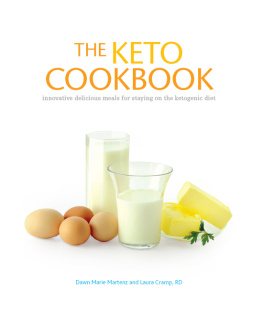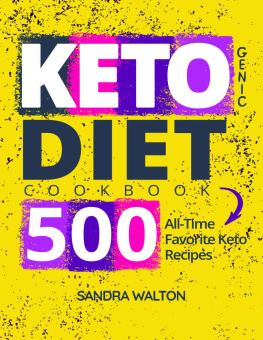THE KETO COOKBOOK
Innovative Delicious Meals for
Staying on the Ketogenic Diet
Dawn Marie Martenz
Laura Cramp, RD, LD, CNSC

Visit our website at www.demoshealthpub.com
ISBN: 978-1-936303036
E-book ISBN: 9781617050930
Acquisitions Editor: Noreen Henson
Compositor: diacriTech
Printer: Bang Printing
2011 by Dawn Marie Martenz and Laura Cramp. All rights reserved. This book is protected by copyright. No part of it may be reproduced, stored in a retrieval system, or transmitted in any form or by any means, electronic, mechanical, photocopying, recording, or otherwise, without the prior written permission of the publisher.
Medical information provided by Demos Health, in the absence of a visit with a healthcare professional, must be considered as an educational service only. This book is not designed to replace a physician's independent judgment about the appropriateness or risks of a procedure of therapy for a given patient. Our purpose is to provide you with information that will help you make your own healthcare decisions.
The information and opinions provided here are believed to be accurate and sound, based on the best judgment available to the authors, editors, and publisher, but readers who fail to consult appropriate health authorities assume the risk of injuries. The publisher is not responsible for errors or omissions. The editors and publisher welcome any reader to report to the publisher any discrepancies or inaccuracies noticed.
CIP data is available from the Library of Congress
Special discounts on bulk quantities of Demos Medical Publishing books are available to corporations, professional associations, pharmaceutical companies, health care organizations, and other qualifying groups. For details, please contact:
Special Sales Department
Demos Medical Publishing
11 West 42nd Street, 15th Floor
New York, NY 10036
Phone: 800-532-8663 or 212-683-0072
Fax: 212-941-7842
E-mail:
Made in the United States of America
11 12 13 14 / 5 4 3 2 1
Foreword
T he ketogenic diet has a storied history. While its introduction in modern neurology for use in the treatment of epilepsy is typically attributed to Dr. Samuel Livingston in Baltimore, even Dr. Livingston describes a reference to fasting to cure seizures from the Bible in his book published in 1963, Living with Epileptic Seizures.
Dr. Livingston's successor as the Physician-in-Charge of The Johns Hopkins Hospital Epilepsy Clinic was Dr. John M. Freeman. Dr. Freeman essentially resurrected the diet as a standard treatment for at least medically intractable epilepsy during the second half of his career when he redirected his attention from aspects of birth defects and ethics to a concentration in pediatric epilepsy. His book The Ketogenic Diet, written with his Hopkins colleagues Eileen Patty Vining, M.D., and the late (and beloved) Diana Pillas, served as an important guide for parents of children with epilepsy. Dr. Freeman trained many leading child neurologists including Eric Kossoff, M.D., who has continued clinical studies of the ketogenic diet and widened its use, including extension to the idiopathic epilepsies, for example, absence epilepsy, and variations on the diet, specifically the modified Atkins diet.
The mechanism of the diet's effects remains elusive, although neuroscientists have been actively researching this question. The diet has been determined to be a targeted therapy for certain disorders, specifically glucose transporter deficiency (where the diet provides an alternative to glucose as fuel for the brain), and pyruvate dehydrogenase complex deficiency (where the diet provides for an alternative pathway for the mitochondria to produce energy). Yet metabolic disorders in general represent a minefield where the ketogenic diet can inadvertently worsen an underlying metabolic defect and convert a patient from relative stability to rapid deterioration. Hence, the diet is not a natural alternative for epilepsy and is at least as complicated as taking a drug in terms of the ramifications that can ensue for the body's metabolism.
The diet can be unpleasant and unappetizing and this has been a longstanding concern among physicians and parents. But, at long last, one patient's extremely talented mother brought her love and caring into play, making the ketogenic diet attractive and even delicious. It has been my privilege to work with Mrs. Dawn Martenz and her outstanding family in the epilepsy genetics program at Children's National Medical Center. We decided at a particular point of frustration during her child's treatment that a trial of the diet, although not necessarily considered typical for a child with her daughter Charlotte's diagnosis, Dravet syndrome, would be worth the effort. None of us predicted that the outcome would be a series of recipes and culinary creations that could indeed be considered so appealing, if not delectable, as to warrant this unique cookbook. Together with our outstanding ketogenic team, including Drs. Tammy Tsuchida, Tesfaye Zelleke, and Amy Kao, Mrs. Martenz teamed up with Laura Cramp, R.D., a dietitian who, as in other centers, evolves as the key ingredient of the ketogenic diet clinic. Together they produced this outstanding cookbook that will be among the greatest assets of any family facing the dilemma of using dietary therapy to treat their child's epilepsy. My hat is off to these authors, and those families, for the fantastic efforts and results that come with this work.
Phillip L. Pearl, MD
Chief, Division of Child Neurology
Children's National Medical Center
Professor of Pediatrics, Neurology, and Music
The George Washington University of Medicine and Columbian College of Arts and Sciences
Washington, DC
Appropriate Adminstration and Potiential Complications of the Ketogenic Diet
Amy Kao, MD
T he ketogenic diet may have less obvious side effects than medications, but it has its own set of possible problems and should be treated just like an antiseizure medication. The family and patient should talk with their neurologist about whether the ketogenic diet might be a good treatment option. Then, the neurologist should refer the patient to a specialized team involving a dietitian and another neurologist who have expertise and experience in managing patients on the ketogenic diet. This team should review the ketogenic diet in detail with the family, confirm that the patient is a good candidate for the diet, prepare the family for initiation, supervise the start of the diet, and communicate with and see the family frequently throughout the time the ketogenic diet is being used, just as when a medication is prescribed.
There are some problems that can occur, especially during the start of the ketogenic diet. Because of these possible problems, patients are admitted to the hospital for initiation of the ketogenic diet, so that monitoring for symptoms and frequent blood work can be done.
HYPOGLYCEMIA (LOW BLOOD SUGAR)
In general, blood sugars are relatively low on the ketogenic diet, but if caloric needs are not calculated properly, they can get dangerously low and cause symptoms such as sleepiness, vomiting, nervousness, trembling, and sweatiness. In such cases, a certain amount of sugar given in the form of apple juice or unflavored Pedialyte or even intravenous fluids (without sugar), might be necessary.
EXCESSIVE ACIDOSIS (THE BLOOD IS TOO ACIDIC)
Again, in general, the acidity of the blood is relatively high while on the ketogenic diet due to the acidity of ketones. However, if it is too acidic, there may be symptoms such as panting, irritability, increased heart rate, facial flushing, unusual fatigue, and vomiting. A certain amount of juice or unflavored Pedialyte, or intravenous fluids might be needed. If the level stays low, additional bicarbonate might be prescribed as a daily medication to balance out the acidity. This is a common complication when starting the ketogenic diet, but usually resolves after a short period of time if the patient remains well hydrated.














